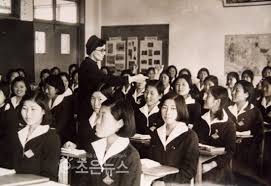
Professor Kim Eun-gyong
By Kim Eun-gyong
Contributing Writer
This is the first in a series of articles about history of English education in Korea ― ED.
English language education was first introduced to Korea in 1883, when the Joseon government opened an English language school in order to train interpreters. Since then, English has enjoyed the status as the most popular foreign language during the greater part of its existence in what is today So
uth Korea. The following passage from an article of the Korea Times (dated February 5, 2008) offers an excellent illustration of the current extraordinary status of English in Korea society.
"According to a report by the Samsung Economic Research Institute (SERI), Koreans spend about 15 trillion won ($15.8 billion) on English learning per year. Koreans also topped the applicant list of the Test of English as a Foreign Language (TOEFL) between 2004 and 2005 as about 102,340 out of the 554,942 applicants were Koreans. They also paid 700 billion won toward English examination fees. Enthusiasm for English study has also seen a large number of children, teenagers and even adults going to English-speaking countries like the United States, Australia and Britain to study. Last year some 250,000 under 29 years old went abroad for studying. The English frenzy saw the coining of the term 'goose father,' referring to a father who lives alone in Korea having sent his spouse and children to a foreign country to study English or some other form of advanced study. The goose fathers are estimated to be about 200,000 goose daddies nationwide. Most Koreans start to learn English from middle or elementary school. By the time they graduate, they have already spent about 100,000 hours on English studying, according to the SERI report."
In this remarkable advancement of the English language in Korean society, the government’s educational policies have played crucial roles, for English language education (ELE) has served as the main vehicle of the spread of English in Korea and most of its development has been led and shaped by the educational policies of the highly centralized government.
Therefore, in order to understand why and how the English language has become an important part of present-day Koreans’ lives and to be able to have a glimpse into what the status of the English language will be in the future Korean society, it is necessary to investigate and cultivate our understanding of the government’s past various roles in the development of ELE and the social contexts that brought about the changes made in the government policies on ELE.
My article series will examine the ELE development from the beginning to the present from the perspective of government’s role in it. More precisely, the series will include investigations on the Joseon government’s introduction of ELE, the stunted development of ELE during the Japanese colonial rule, the expansion of ELE under the strong influence of the U.S. military government of Korea and during the Korean War, and the continual development of ELE led by the Korean government.
President Lee Myung-bak has made known his intention to restructure the nationwide system of ELE. As a presidential nominee he pledged to reinforce public education in such a way that all high school graduates can communicate with foreigners without difficulty, and his presidential transition team suggested that all the English classes in high schools be taught in English.
The presidential nominee’s and his presidential transition team’s obvious interest in ELE have intensified citizens’ already heated interest in and worries over ELE and started to show side effects such as a strong backlash from teachers and parents.
Thus, it seems for now that President Lee has given up on his plan to implement immersion programs; the annual task report that the Ministry of Education, Science and Technology presented to him included no mention of English immersion programs. This illustrates just how difficult it is for the government to introduce ELE policies that satisfy the majority of the citizens while having long-lasting positive effects.
Such a gallant attempt will require thorough preparations, including in-depth analyses of the successes or the failures of similar measures taken in the past whether in Korea or in other countries.
This series intends to offer a comprehensive view of the development of ELE in Korea and sound suggestions for a future direction that the Korean government should take with regard to English educational policies.
With such high hopes, I now would like to begin the series by examining Koreans’ contact with the English language before the Joseon government’s introduction of ELE in 1883.
Kim Eun-gyong is an associate professor of applied linguistics and Associate Dean of the Center for International Affairs, Information and Communications University (ICU) in Daejeon. She can be reached at egkimrivera@icu.ac.kr
http://www.koreatimes.co.kr/www/news/special/2009/06/181_21843.html
Tidak ada komentar:
Posting Komentar